There are many places on Earth where it snows, but did you know it snows on other worlds, too? Here are just a few of the places where you might find snow beyond Earth:
Mars
The north pole and south pole of Mars have ice caps that grow and shrink with the seasons. These ice caps are made mainly of water ice—the same kind of ice you’d find on Earth. However, the snow that falls there is made of carbon dioxide—the same ingredient used to make dry ice here on Earth. Carbon dioxide is in the Martian atmosphere and it freezes and falls to the surface of the planet as snow. In 2017, NASA’s Mars Reconnaissance Orbiter took photos of the sand dunes around Mars’ north pole. The
slopes of these dunes were covered with carbon dioxide snow and ice.

NASA’s Mars Reconnaissance Orbiter captured this image of carbon dioxide snow
covering dunes on Mars. Credit: NASA/JPL/University of Arizona
A Moon of Jupiter: Io
There are dozens of moons that orbit Jupiter and one of them, called Io, has snowflakes made out of sulfur. In 2001, NASA’s Galileo spacecraft detected these sulfur snowflakes just above Io’s south pole. The sulfur shoots into space from a volcano on Io’s surface. In space, the sulfur quickly freezes to form snowflakes that fall back down to the surface.
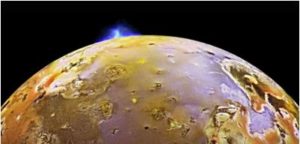
A volcano shooting molten sulfur out from the surface of Io. Credit: NASA/JPL-Caltech
A Moon of Saturn: Enceladus
Saturn’s moon, Enceladus, has geysers that shoot water vapor out into space. There it freezes and falls back to the surface as snow. Some of the ice also escapes Enceladus to become part of Saturn’s rings. The water vapor comes from a heated ocean which lies beneath the moon’s icy surface. (Jupiter’s moon Europa is also an icy world with a liquid ocean below the frozen surface.) All of this ice and snow make Enceladus one of the brightest objects in our solar system.
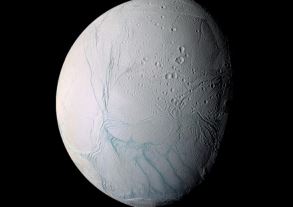
Enceladus as viewed from NASA’s Cassini spacecraft. Credit: NASA
A Moon of Neptune: Triton
Neptune’s largest moon is Triton. It has the coldest surface known in our solar system. Triton’s atmosphere is made up mainly of nitrogen. This nitrogen freezes onto its surface covering Triton with ice made of frozen nitrogen. Triton also has geysers like Enceladus, though they are smaller and made of nitrogen rather than water.
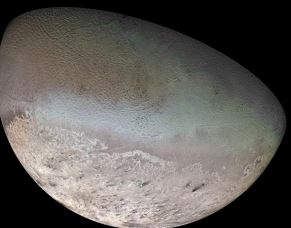
The Voyager 2 mission captured this image of Triton. The black streaks are created by
nitrogen geysers. Credit: NASA/JPL/USGS
Pluto
Farther out in our solar system lies the dwarf planet Pluto. In 2016, scientists on the New Horizons mission discovered a mountain chain on Pluto where the mountains were capped with methane snow and ice.
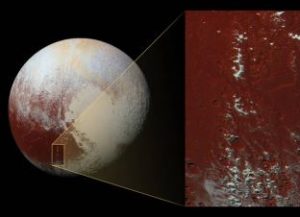
The snowy Cthulhu (pronounced kuh-THU-lu) mountain range on Pluto.
Credits: NASA/JHUAPL/SwRI
Beyond Our Solar System
There might even be snow far outside our solar system! Kepler-13Ab is a hot, giant planet 1,730 light years from Earth. It’s nine times more massive than Jupiter and it orbits very close to its star. The Hubble Space Telescope detected evidence of titanium oxide— the mineral used in sunscreen—in this planet’s upper atmosphere. On the cooler side of Kepler-13Ab that faces away from its host star, the planet’s strong gravity might cause the titanium oxide to fall down as “snow.”
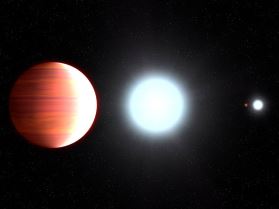
This is an artist’s illustration of what Kepler-13Ab might look like. Credit:
NASA/ESA/G. Bacon (STScI)
Want to learn more about weather on other planets? Check out NASA Space Place:
https://spaceplace.nasa.gov/planet-weather


